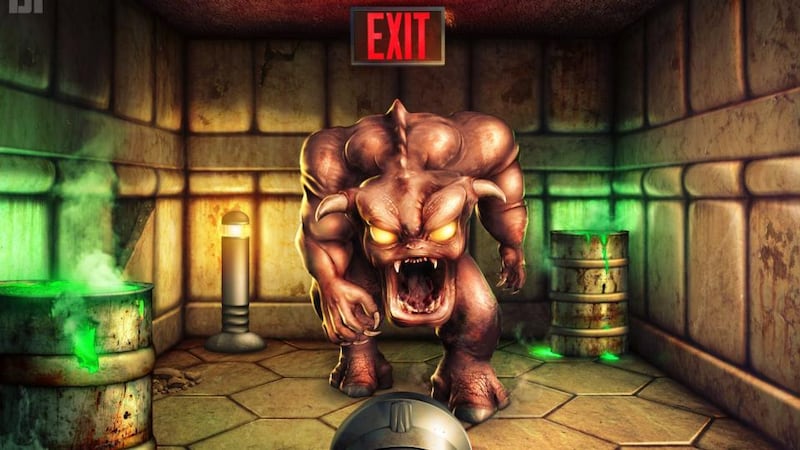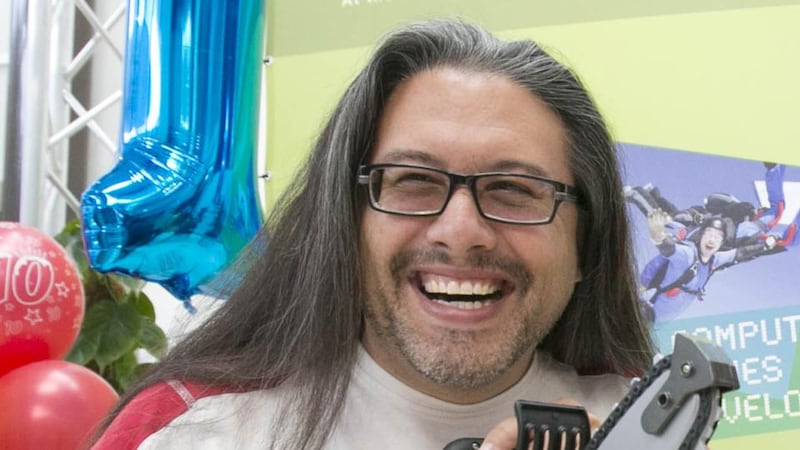John Romero looks like a combination of biker and roadie in a metal band. He has long hair, a black T-shirt and jeans with patches on them. His wife Brenda is dressed all in black as well – in contrast to her striking blonde hair and ready smile as she takes her seat beside him.
Over the previous 30 minutes, a windowless lecture hall in Galway's Pulse College (which offers game developer courses) has filled up with more than 70 people from the local gaming community.
A few of them are wearing T-shirts depicting some of John's best known games: Wolfenstein 3D, Doom, Quake. All were notorious for their graphic violence, but also loved by the tens of millions who immersed themselves in their gripping gameplay.


Brenda has worked on lots of best-selling games as well, including Wizardry, an influential role-playing game, which was an inspiration for the Final Fantasy series. More recently she has been developing games to go with The Walking Dead TV series. She is the longest continuously serving woman in the videogame industry, having entered the business in 1981, at the tender age of 15.
The couple are in Galway on a six-week grand tour as part of a Fulbright US specialist award granted to Brenda, who is game designer in residence at the University of Santa Cruz, New Mexico.
Over these six weeks she is visiting places where videogames are either taught or made, and John is along for most the trip. Her goal is to work out how Ireland can do things better in the global games industry, which DFC Intelligence estimates will grow from $68 billion in 2013 to $96 billion by 2018.
The couple work together as consultants in Romero Games (romero.com). They represent the promised land for game developers: artistic fulfilment and the potential to make a fortune.
The gamer’s life
Paul Conway
, a Galway-based game artist from DoomCube, introduces his two guests. He’d only met them a few days earlier, but after two hours of talking about games, they’d agreed to travel west.
Conway’s introduction is long, covering the Romeros’ lifetimes in games. It starts in the early 1980s, when games were two-dimensional and had to be simple because they took ages to load. It ends today, when games can often cost more to develop than a movie.
“We have to live up to those introductions now. We are very ordinary people!” Brenda laughs. “You can ask anything without offending us. We have been asked pretty much anything!”
“Many times!” John adds, laughing as he sits even further back in his seat.
The questions start spitting out from the audience. What do they make of Ireland’s game developer scene so far, asks someone in the front row.
“It’s bigger than we thought it was,” John replies. “We were in Dublin for a while so we got to go visit Digit, bitSmith Games, StoryToys. We spent the first week just meeting developers before going to the universities.”
Brenda says they lived in Silicon Valley, the “hot bed” for the biggest game makers. “It is sort of normalised there. There is a sense of energy here, though – let’s bring our laptops to the pub and show one another what we’re working on – that’s just not really there.
“I just felt really recharged by the community of it, which I wish we had.”
“There are thousands of developers where we come from,” John interjects.
“A factor in Silicon valley is that we have is rightful paranoia,” Brenda says. “If you show your game idea, your game idea could get stolen . . . that has happened to John twice in Silicon Valley.”
“If a game is good it is going to get ripped off,” John says. “Our general policy is, we don’t go live until we think we can’t get caught,” Brenda continues.
"Yeah, because China can basically generate a game super-quick," John adds. "They change some of the code, switch out some graphics and bang – they have a game. So we don't talk about stuff."
Another question: How do you make your game stand out from the hundreds launched every day?
“Something innovative and with quality,” John replies with a smile.
“It’s about building a following among game developers,” Brenda adds. “Building good relationships with the press always helps. Enter a games competition. Being a winner or a finalist can catapult you. The reality, though, is it’s 10 years.”
“It will take 10 years to make something great,” John continues.
“All the game developers I know say it takes 10 years to make a great game,” Brenda says. “It was 14 for me, so I was lagging I guess. That’s on average. It is about getting your warm up games out of the way.”
“They all build on each other,” John adds. His first game was published in 1984, and in those days he made a game every two months. Each time he got better. “It takes tonnes and tonnes of practice.”
Learning by doing
Failure can also help, Brenda says. When she started out in 1981, she worked with legendary games developer Sir-Tech Software on what was then the emerging genre of role-playing games.
“By the time I took a lead role, I had been working seven years. It was award- winning game after award-winning game, which is not the way it is like!”
Brenda said not every game had done as well as expected. In 2003 for example she had worked on developing Playboy: the Mansion, which was supposed to be for men, but women loved the game, she says.
“We were being complemented by women, so something was wrong! Nude women’s bodies are beautiful, so there was no reason why they’d hate the game. But that wasn’t our target market.
“I made an adventure game for women . . . it was a magazine publishing game, and not a you-want-to-be-Hugh-Hefner- game and all that stuff.”
In 2012, Brenda says, she failed badly when she pulled out of a Kickstarter plan to crowdfund her own game called Shaker. She had raised $250,000 but the game just wasn't working.
“It was one of the best things that happened to me,” she said. “It failed and you knew it wasn’t going to make it. You know what – I screwed up!”
Brenda then mentions Daikatana, John's 2000 first person-shooter game, which he doesn't discuss in detail. It became infamous for the amount of pre-launch hype – and worse, that it spectacularly failed to sell despite costing millions.
"How do you go up from Quake? The world didn't end. You can't hit every time," Brenda says. "You name a famous game developer and I'll tell you what their bomb was. Ultimately, I would much rather fail making games than insurance policies."
Industry comes on
Another question is asked. How has the games industry changed over the decades?
“I think the graphics arms race is over now,” John says. “They are only going to squeeze more pixels onto the screen that you can’t see. It’s all about game design innovation. Angry Birds, for example, could have been done in 1980 but wasn’t!”
"Culturally I am really pleased to see where it's gotten. With Doom, we just tried to make the greatest thing that we could envision. We weren't thinking back then: this is going to live forever!"
Brenda says the games industry as a career is now more acceptable.
“We had a press photo-op recently with the new Minister of Education in Ireland and I’m thinking, just imagine if you rewind back to 1994. Doom [infamous for its violent graphics] has been out for just a little bit. What minister wants their picture taken with its creator? No one!”
“Culturally, I really feel games have arrived,” she says. “We are still in the somewhat bizarre phase where kids say ‘I’d like to go make videogames’, and parents say ‘What?!’ In 10 or 15 years that won’t happen.”
A question is then asked about the Oculus Rift, a virtual reality head-mounted display tipped to revolutionise gaming. John Carmack, who worked with John on Doom and Quake, is a senior figure in the company, Oculus VR, which was acquired by Facebook for $2 billion.
“We think the Oculus is cool,” John says. “It looks really neat but it is going to be super niche.”
Brenda calls it “a super-interesting piece of technology”, but she believes its real applications are in training and health and so on, and not for playing videogames.
“It’s a gigantic hole sucking in programmers. I think it is an exciting technical thing, but I am not ready to make a game for it.”
Irish connections
Brenda has a soft spot for Ireland: “My family was originally from west Co Cork. I have a soft spot for this country. It is so frigging amazing!”
(Another connection: Adrian Carmack, the artist on Doom and Quake, recently bought a hotel here – the Heritage Golf & Spa resort in Killenard, Co Laois. The fact that a games artist could buy a five-star hotel does shows how far the industry has come.)
The Irish Times asks a question. What does Ireland need to do?
John: “Make a huge amazing game and that will pull everybody in!”
Brenda: “It is not necessarily something that is missing. There is a pattern that I noticed . . . I know of a lot of people who say if only I could get funding then I could do it!”
“It is common sense,” John interjects. “’Have you made games before?’ ‘No.’ ‘Then why should I give you money?’”
Brenda cautions developers not to give away their ideas too cheaply.
"You have a good idea, and you need $1,000 a month. I'll fund you if you give me 80 per cent, say. But what if your idea is Minecraft [one of the world's biggest games]. Are you happy I own it? If you can make a game, try to retain full ownership."
“Make it at home, at night, at weekends,” John says.
After studying the Irish games sector, Brenda concludes that Enterprise Ireland could invest more in funding developers.
“Enterprise Ireland funds R&D, not games. That has to be fixed. Games are viewed as this R&D thing and not this project-based arts thing.
“It is not so different from movies,” she says. “People’s ears are open and prepared to look at things from a different perspective, but wouldn’t it be great if games could get the same tax breaks in Ireland that movies get?”
The UK and other European countries provide greater financial incentives to help games makers, she says. “Ireland exports its brains too.” When budding games developers finish their education, they often have to emigrate.
“Anybody can say they have got anything, but you need to be making games,” Brenda says.
“Make small games first,” John concludes. “And remember, it takes 10 years!”


















